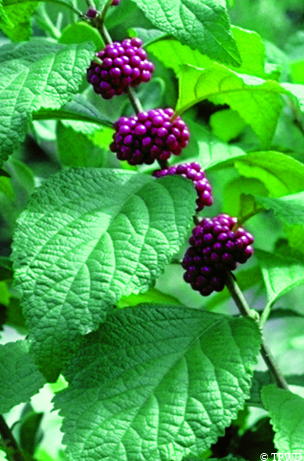
Flora Fact: Beautyberry’s Purple Fruit Is a Wildlife Staple
Beautyberry’s purple fruit is a wildlife staple.
By Sheryl Smith-Rodgers
Four years ago, we planted a foot-high American beautyberry in a shaded corner of our yard. Then we waited. And waited and waited. Three years passed. So did a drought. The shrub grew some but didn’t put out the beautiful purplish fruit for which the native species is named.
Finally, our patience paid off. Last June, the beautyberry shot up, and tiny white flowers budded at the leaf axils (point where leaf adjoins stem), a sure sign that this year we’d be rewarded with berries. So would our resident wildlife.
Unless devoured, the mulberry-looking fruit clusters of a beautyberry — also called French mulberry — can remain on its drooping branches long after leaves have yellowed and dropped in the fall. The fruit’s vivid splash of violet color also impressed Swedish botanist Carl Linnaeus, who in 1741 derived the plant’s genus name of Callicarpa from two Greek words: kallos (beautiful) and karpos (fruit). He chose the species name — americana — to distinguish the plant from Old World species.

As an understory shrub, American beautyberry ranges across East Texas and the southeastern U.S. in moist thickets and woodlands.
Northern cardinals, mockingbirds, robins, northern bobwhites and other bird species eat the fruit. So do raccoons, opossums, squirrels and other mammals. White-tailed deer browse the foliage.
TIP:
|
In the winter, consider pruning beautyberries to 12 inches high or all the way to the ground. The new growth will produce more flowers and fruit. |

